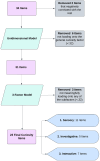The Infant and Toddler Curiosity Questionnaire: A Validated Caregiver-Report Measure of Curiosity in Children From 5 to 24 Months
- PMID: 39853857
- PMCID: PMC11758190
- DOI: 10.1111/infa.70001
The Infant and Toddler Curiosity Questionnaire: A Validated Caregiver-Report Measure of Curiosity in Children From 5 to 24 Months
Abstract
Humans are curious. Especially children are known for their drive to explore and learn, which is crucial for developing in and navigating through our complex world. Naturally, some children may be more curious than others, leading to differences in how they structure their own learning experiences, subsequently impacting their developmental trajectories. However, there is a gap in the research field for a reliable measure of such differences early in development. Across three studies, we present the development and assessment of the Infant and Toddler Curiosity Questionnaire (ITCQ), the first caregiver report measure to fill this gap. Items cover observable exploration behaviors in 5- to 24-month-olds to capture general tendencies of their desire to actively explore their immediate surroundings and are evaluated on a 7-point Likert-scale. Exploratory factor analyses and structural equation modeling on a sample of N = 370 UK caregivers led to the final selection of 23 items and provided evidence that the scale allows the reliable computation of an overall curiosity score, with three emergent subscales (Sensory, Investigative, and Interactive) explaining additional variance in the data. Furthermore, the scale had good test-retest reliability after 7-14 days (N = 67) and related to the child's temperament (N = 75; positively with surgency and effortful control, negatively with negative affect) offering evidence of its validity as a trait measure. Together, these results support the scale's reliability and validity, showcasing the ITCQ as a powerful tool for developmental research.
Keywords: early development; exploration; individual differences; infant curiosity; psychometrics; trait curiosity.
© 2025 The Author(s). Infancy published by Wiley Periodicals LLC on behalf of International Congress of Infant Studies.
Conflict of interest statement
The authors declare no conflicts of interest.
Figures
Similar articles
-
Validation of the I- and D-type epistemic curiosity scale among young Chinese children and implications on early curiosity nurture.BMC Psychol. 2024 Dec 30;12(1):795. doi: 10.1186/s40359-024-02286-4. BMC Psychol. 2024. PMID: 39736646 Free PMC article.
-
Development and initial testing of the brief adolescent smoking curiosity scale (ASCOS).Addict Behav. 2018 Mar;78:67-73. doi: 10.1016/j.addbeh.2017.11.008. Epub 2017 Nov 7. Addict Behav. 2018. PMID: 29127786 Free PMC article. Clinical Trial.
-
Exploring individual differences in infants' looking preferences for impossible events: The Early Multidimensional Curiosity Scale.Front Psychol. 2023 Feb 2;13:1015649. doi: 10.3389/fpsyg.2022.1015649. eCollection 2022. Front Psychol. 2023. PMID: 36817372 Free PMC article.
-
Measuring an understudied factor in medical education - development and validation of the medical curiosity scale.Med Educ Online. 2023 Dec;28(1):2198117. doi: 10.1080/10872981.2023.2198117. Med Educ Online. 2023. PMID: 37014965 Free PMC article.
-
Influence of the child's perceived general health on the primary caregiver's health status.Health Qual Life Outcomes. 2018 Jan 10;16(1):8. doi: 10.1186/s12955-018-0840-z. Health Qual Life Outcomes. 2018. PMID: 29321017 Free PMC article.
References
-
- Altmann, E. C. , de Boer E., Eiteljoerge S., et al. 2023. “The Development of the Early Child Curiosity Questionnaire (ECCQ).” In [Poster Presentation] 8th Lancaster Conference on Infant & Early Child Development, Lancaster, UK, August 23.
MeSH terms
Grants and funding
LinkOut - more resources
Full Text Sources
Medical
Miscellaneous




